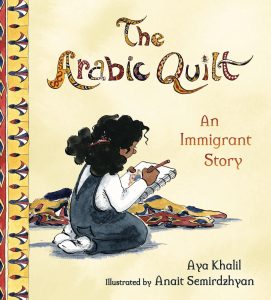 The Arabic Quilt: An Immigrant Story
The Arabic Quilt: An Immigrant Story
Written by Aya Khalil
Illustrated by Anait Semirdzhyan
Tilbury House Publishers, 2020, 36 pp (unpaged)
ISBN: 978-0884487548
Kanzi, a young Egyptian American girl, moves to a new town at the start of third grade. As she is immersed in the school environment, she experiences the challenges many children navigate when encountering cultural differences. When her father packs her a kofta (spiced meatball) sandwich for lunch, she secretly wishes it was peanut butter and jelly for the sake of not being different, a feeling many immigrant children can relate to. Kanzi forgets her sandwich at home and her mother shows up to school wearing a hijab and calling her “habibti,” an Arabic term of endearment meaning beloved. Some of her classmates tease her and laugh because her mother’s language sounds funny to them. Kanzi has an emotional reaction and her teacher pulls her aside to tell her that being bilingual is beautiful, affirming her identity. Later that night, Kanzi wraps herself in her grandmother’s quilt and writes a poem about how she’s feeling regarding her identity. After her teacher sees her poem and quilt, she takes the opportunity to create a class project making a quilt or paper arrangement, with the help of Kanzi’s mother who writes the students’ names in Arabic. Kanzi states how beautiful her mother looks, emphasizing the pride she feels to see her mother. The paper quilt project excites her classmates who initially teased her about her biliteracy and soon everyone is excited to see their name written in a new language. The teacher hangs the quilt outside their classroom and inspires a celebration of multilingualism across the school as other classrooms decide to write classmates’ names in other heritage languages.
This book uses Arabic words to translanguage when speaking about cultural staples. Instead of saying lentil soup, the author makes a point to call it shurbet ‘ads. There is also a glossary of Arabic-English words that are mentioned in the text with the transliteration included. The word teita (grandmother) is included as well, which feels especially authentic because it is in the Egyptian dialect, not Modern Standard Arabic.
The family in this story appears to be an accurate representation of an Egyptian American household. The father is reading a newspaper written in Arabic print that reads akhbar masr (Egyptian news). Also, Kanzi’s family speaks to her in both Arabic and English. It’s especially endearing that the family is diverse and accurately represented with Kanzi, her brother, and father having darker skin tones and her mother having lighter skin. Egyptians are diverse and it’s refreshing to see Black Arabs represented in this way. This book dives into heavy topics in a way that is comprehensible and relatable to students, regardless of their heritage. It emphasizes the importance of acceptance, self-love, and the richness of diversity and inclusion.
Some texts that are similar in theme would be Mirror by Jeannie Baker (2010), which is a bilingual book that follows an Australian child and a Moroccan child through their day. This book highlights similarities and differences between the Western and Eastern world (Editor: see a critical review of this book for another perspective). Another connection is to The Name Jar by Yangsook Choi (2003), because of the pressure the main character feels to fit in, contemplating changing her name before deciding on being brave and unapologetically claiming her identity. This book connects to The Arabic Quilt because the main character, Kanzi, also grapples with her identity after immigrating to the United States.
This text feels especially authentic because the author, Aya Khalil, immigrated from Egypt herself as a child. Khalil draws from personal experiences as she reflects on what it was like to live in a country where her heritage language is a low-incidence language. The Arabic Quilt: An Immigrant Story is the author’s first published text and it’s been internationally recognized by winning awards like the 2021 Arab American Children’s Book, the Children’s Africana Book Award (CABA) 2021 Honor Book, and a 2021 Notable Social Studies Book (NCSS). More information about her can be found on her website.
The illustrator, Anait Semirdzhyan, was born in Kazakhstan, grew up in Armenia, and now lives in Seattle with her family. She used pencil sketches and watercolor to illustrate this book. By using this method on a white page, she creates a focus on Kanzi’s family and the world around her. More information about her can be found on her website.
Douha Abbasher, Texas Woman’s University
© 2023 by Douha Abbasher

